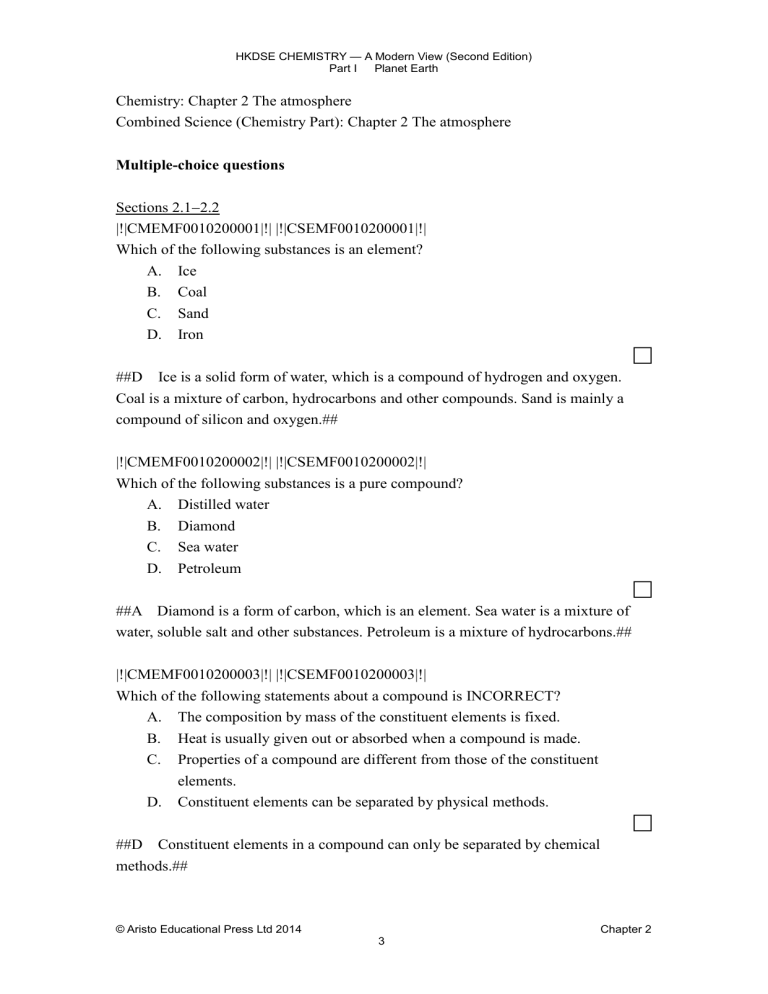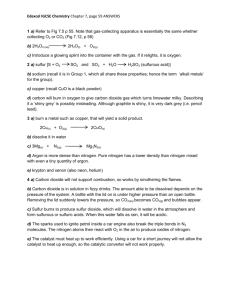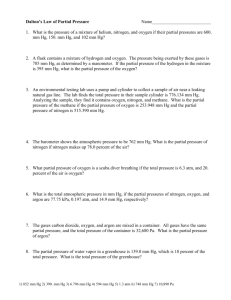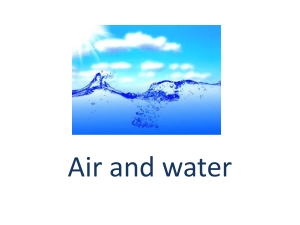
HKDSE CHEMISTRY — A Modern View (Second Edition) Part I Planet Earth Chemistry: Chapter 2 The atmosphere Combined Science (Chemistry Part): Chapter 2 The atmosphere Multiple-choice questions Sections 2.12.2 |!|CMEMF0010200001|!| |!|CSEMF0010200001|!| Which of the following substances is an element? A. Ice B. Coal C. D. Sand Iron ##D Ice is a solid form of water, which is a compound of hydrogen and oxygen. Coal is a mixture of carbon, hydrocarbons and other compounds. Sand is mainly a compound of silicon and oxygen.## |!|CMEMF0010200002|!| |!|CSEMF0010200002|!| Which of the following substances is a pure compound? A. Distilled water B. C. D. Diamond Sea water Petroleum ##A Diamond is a form of carbon, which is an element. Sea water is a mixture of water, soluble salt and other substances. Petroleum is a mixture of hydrocarbons.## |!|CMEMF0010200003|!| |!|CSEMF0010200003|!| Which of the following statements about a compound is INCORRECT? A. The composition by mass of the constituent elements is fixed. B. C. D. Heat is usually given out or absorbed when a compound is made. Properties of a compound are different from those of the constituent elements. Constituent elements can be separated by physical methods. ##D Constituent elements in a compound can only be separated by chemical methods.## © Aristo Educational Press Ltd 2014 Chapter 2 3 HKDSE CHEMISTRY — A Modern View (Second Edition) Part I Planet Earth |!|CMEMF0010200004|!| |!|CSEMF0010200004|!| Which of the following processes decomposes the compound into its constituent elements? (1) Heating mercury(II) oxide strongly in a Bunsen flame (2) Electrolysis of water (3) Dissolving table salt in water A. (1) and (2) only B. (1) and (3) only C. (2) and (3) only D. (1), (2) and (3) ##A Mercury(II) oxide decomposes into mercury and oxygen on strong heating. Electrolysis of water gives hydrogen and oxygen.## |!|CMEMF0010200005|!| |!|CSEMF0010200005|!| Iron(II) sulphide is a compound because A. it consists of more than one element. B. the composition by mass of its constituent elements is fixed. C. it reacts with an acid. D. it is non-magnetic. ##B## |!|CMEMF0010200006|!| |!|CSEMF0010200006|!| Which of the following is NOT a chemical property of sodium? A. It reacts with water to form sodium hydroxide. B. It tarnishes rapidly when exposed in air. C. It can be cut into small pieces easily with a knife. D. It burns vigorously in air with a golden yellow flame. ##C## Section 2.3 |!|CMEMF0010200007|!| |!|CSEMF0010200007|!| Which of the following substances is the most abundant in air? A. Oxygen B. Nitrogen © Aristo Educational Press Ltd 2014 Chapter 2 4 HKDSE CHEMISTRY — A Modern View (Second Edition) Part I Planet Earth C. D. Carbon dioxide Water vapour ##B Nitrogen makes up about 78% of the air.## |!|CMEMF0010200008|!| |!|CSEMF0010200008|!| The composition by volume of argon, carbon dioxide, nitrogen and oxygen in air can be arranged in descending order as A. oxygen, nitrogen, carbon dioxide, argon. B. nitrogen, oxygen, argon, carbon dioxide. C. D. argon, carbon dioxide, nitrogen, oxygen. oxygen, argon, carbon dioxide, nitrogen. ##B Air contains nitrogen (78%), oxygen (21%), argon (0.93%), carbon dioxide (0.03%), water vapour and other gases.## |!|CMEMH0010200009|!| |!|CSEMH0010200009|!| A scientist extracted a sample of ‘oxygen’ from air by removing the nitrogen and carbon dioxide in the sample. The scientist then compared the mass of a known volume of the ‘oxygen’ sample (m1) with that of the same volume of pure oxygen (m2) under the same condition. It was found that m1 was greater than m2. Which of the following gases is likely to be present in the ‘oxygen’ obtained to account for the result that m1 is greater than m2? A. Neon B. Argon C. Methane D. Water vapour ##B## |!|CMEMF0010200010|!| |!|CSEMF0010200010|!| Which of the following statements is/are correct? (1) Air is a mixture of two gases, nitrogen and oxygen. (2) The composition of air varies slightly from time to time. (3) The gases in air are unreactive. A. (1) only B. (2) only C. (1) and (3) only © Aristo Educational Press Ltd 2014 Chapter 2 5 HKDSE CHEMISTRY — A Modern View (Second Edition) Part I Planet Earth D. (2) and (3) only ##B Air also contains a small amount of water vapour and noble gases. However, the amount of water vapour in air varies slightly from time to time.## |!|CMEMF0010200011|!| |!|CSEMF0010200011|!| Which of the following statements about nitrogen are INCORRECT? (1) It is flammable. (2) It is a liquid at room temperature. (3) It is the most abundant component in the atmosphere. A. B. C. D. (1) and (2) only (1) and (3) only (2) and (3) only (1), (2) and (3) ##A Nitrogen is not flammable. It is a gas at room temperature.## Section 2.4 |!|CMEMF0010200012|!| |!|CSEMF0010200012|!| Which of the following methods can be used to separate oxygen and nitrogen from liquid air? A. Filtration B. Crystallization C. Sublimation D. Fractional distillation ##D## |!|CMEMF0010200013|!| |!|CSEMF0010200013|!| Oxygen and nitrogen can be separated from liquid air by fractional distillation since they have different A. densities. B. melting points. C. boiling points. D. chemical properties. ##C## © Aristo Educational Press Ltd 2014 Chapter 2 6 HKDSE CHEMISTRY — A Modern View (Second Edition) Part I Planet Earth |!|CMEMF0010200014|!| |!|CSEMF0010200014|!| Consider the steps to separate nitrogen and oxygen from air listed below: (1) Air is liquefied by repeated cooling and compression. (2) Nitrogen boils off as gas. (3) Oxygen boils off as gas. (4) Liquid air is warmed up bit by bit. Which of the following shows the correct sequence of the steps? A. B. C. (1) (4) (2) (3) (4) (2) (3) (1) (1) (4) (3) (2) D. (4) (3) (2) (1) ##A## |!|CMEMF0010200015|!| |!|CSEMF0010200015|!| The following table shows the boiling points of some of the components in a sample of liquid air. Gas Boiling point (C) O2 183 Ar 186 N2 196 Which of the following correctly shows the order of the gases being distilled out when the liquid air sample undergoes fractional distillation? A. O2, Ar, N2 B. N2, Ar, O2 C. N2, O2, Ar D. O2, N2, Ar ##B The component with the lowest boiling point will be distilled out first.## |!|CMEMF0010200016|!| |!|CSEMF0010200016|!| Which of the following statements about argon is/are INCORRECT? (1) It is an element. (2) It is a coloured gas. (3) Its density is lower than that of air. A. (1) only B. (2) only © Aristo Educational Press Ltd 2014 Chapter 2 7 HKDSE CHEMISTRY — A Modern View (Second Edition) Part I Planet Earth C. D. (1) and (3) only (2) and (3) only ##D Argon is colourless and has a higher density than air.## |!|CMEMF0010200017|!| |!|CSEMF0010200017|!| Which of the following gases can be obtained from the fractional distillation of liquid air? A. Helium B. Neon C. D. Argon Carbon dioxide ##C## |!|CMEMF0010200018|!| |!|CSEMF0010200018|!| Which of the following statements about the use of atmospheric gases is INCORRECT? A. Carbon dioxide is used in food packaging. B. Nitrogen is used in the production of ammonia. C. D. Neon is used in advertising signs. Argon is used to fill light bulbs. ##A Nitrogen is used in food packaging.## |!|CMEMF0010200019|!| |!|CSEMF0010200019|!| Which of the following is NOT the physical property of oxygen? A. It is odourless. B. It supports the combustion of fuels. C. It is slightly soluble in water. D. It has a boiling point of 183C. ##B## |!|CMEMF0010200020|!| |!|CSEMF0010200020|!| Which of the following are the uses of nitrogen? (1) As a refrigerant (2) Making fertilizers © Aristo Educational Press Ltd 2014 Chapter 2 8 HKDSE CHEMISTRY — A Modern View (Second Edition) Part I Planet Earth (3) Used in food packaging A. (1) and (2) only B. (1) and (3) only C. (2) and (3) only D. (1), (2) and (3) ##D## Section 2.5 |!|CMEMF0010200021|!| |!|CSEMF0010200021|!| How can we test for the presence of oxygen in a test tube? A. Add water to the test tube to see if the gas dissolves. B. Put a glowing splint into the test tube to see if the splint relights. C. Put a burning splint into the test tube to see if a ‘pop’ sound is heard. D. Put a piece of wet pH paper into the test tube to see if there is a colour change. ##B Oxygen relights a glowing splint as it supports burning.## |!|CMEMF0010200022|!| |!|CSEMF0010200022|!| Which of the following statements about a mixture of carbon and oxygen is correct? A. The composition by mass of carbon and oxygen is fixed. B. It can relight a glowing splint. C. They can be separated by chemical methods. D. It turns limewater milky. ##B Oxygen in the mixture can relight a glowing splint.## |!|CMEMF0010200023|!| |!|CSEMF0010200023|!| Which of the following statements concerning oxygen is correct? A. B. C. D. Oxygen is a gas with a characteristic odour. It turns limewater milky. It is the most abundant constituent gas in breathed air. It is used in oxy-acetylene flame for cutting and welding metals. ##D Oxygen cannot turn limewater milky. Nitrogen is the most abundant constituent gas in breathed air.## © Aristo Educational Press Ltd 2014 Chapter 2 9 HKDSE CHEMISTRY — A Modern View (Second Edition) Part I Planet Earth |!|CMEMF0010200024|!| |!|CSEMF0010200024|!| Which of the following are NOT the properties of oxygen? (1) It gives a ‘pop’ sound with a burning splint. (2) It turns limewater milky. (3) It extinguishes a glowing splint. A. (1) and (2) only B. (1) and (3) only C. (2) and (3) only D. (1), (2) and (3) ##D Hydrogen gives a ‘pop’ sound with a burning splint while oxygen relights a glowing splint.## © Aristo Educational Press Ltd 2014 Chapter 2 10




